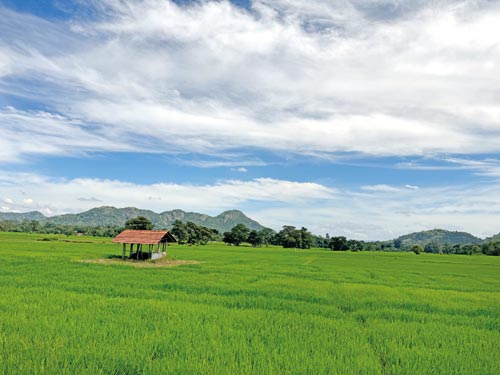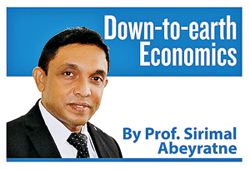Worn out hoe blades
View(s):
Rice fields in the East
One day Lakshman and I had made arrangements to visit Deeptha’s Sancta Maria Hybrid Vehicle Repair Centre in Marawila. As agreed, on the way there I had to pick up Lakshman at the Kelani bridge. He advised me to exit Colombo city as early as possible in order to avoid incoming morning traffic flow to the city.
He was happy to join me on this trip. Besides everything else, he had a hidden motive too, which was not unknown to me: He could avoid his maid servant, Jane’s monotonous breakfast at home! Instead, he could enjoy one of his favourite meals at a popular restaurant on the way. For that breakfast at the restaurant, we must leave Colombo early morning without getting late.
After about a one and half-hour drive from Colombo passing Kochchikade, we reached his chosen restaurant for breakfast. And we ordered a few common items of a typical Sri Lankan breakfast – string hoppers, bread, egg roti, dhal curry, potato curry and coconut sambol as well as, finally, plain tea with crushed raw ginger.
Four-times the country
The middle-aged waiter who served us extended his support for choosing all what we ordered and recommended their good combinations too. After all that he also engaged in a friendly chat with us, while serving our breakfast.
First, he said: “Sir, you are so familiar to me; I was thinking about it”. That remark required me to introduce myself and Lakshman to him. Our introduction encouraged him to talk freely and openly.
“I’m from Anuradhapura, Thambuththegama area.” He started to talk by introducing himself first. “I have two children too; the elder one is doing A-levels now, expecting to go to University. She likes dancing, and she is already earning some bucks through dance performances. It has lessened my burden too, because she finds money for her own expenses. The younger daughter is doing O-levels next year.”
 Lakshman, while admiring what he revealed, asked him a question: “It’s very good, that your daughter has already learnt to earn some money and to become independent. However, what made you to come here from Thambuththegama and work at this restaurant?”
Lakshman, while admiring what he revealed, asked him a question: “It’s very good, that your daughter has already learnt to earn some money and to become independent. However, what made you to come here from Thambuththegama and work at this restaurant?”
He replied: “Unlike in the village, it gives me a regular income every month”.
He clarified his answer: “My father was a farmer, Sir. During his whole lifetime, I remember that he did farming, and he must have dug the ground about “four-times Sri Lanka”. We have 54 worn out hoe blades gathered at home, and all of them were used by him.”
He concluded: “After his lifetime farming, we were still there as a poor rural family. There is no money at hand, even to buy a piece of cloth or some medicines. Why should I do the same? If I stayed there, I would have naturally slipped into the same farming vocation. So, I left the village and came here. After working here, at least I can help my children to study.”
A common story
The story that he told us may not apply to him alone. It is the story of any average farmer family in Sri Lanka. They have been engaged in farming for generations providing food for the country, but they have hardly made any breakthrough in their poor lifestyles.
Domestic agriculture sector is the top-most subsidised and protected production sector in the country. Some of the crops such as paddy are subject to administered prices, while the government institutions are involved in purchasing and providing various extension services. The agriculture sector receives water free of charge and some other inputs such as fertiliser at subsidised prices. The irrigation system maintenance and management, which was the responsibility of the community, is now transferred to the government. And the government uses its tax revenue or borrowings as well as the government administrative machinery to manage the irrigation systems.
During the ancient times, agriculture being the main economic activity of the country generated a surplus that was acquired by the king or his appointed authorities. It is the agriculture surplus which financed infrastructure, roads, irrigation systems, temples and monuments, king’s family and palaces, military and wars, and many others. But in the modern times, the agriculture sector is generally free from taxes – business taxes or income taxes and is dependent on industry and service sectors for its survival.
In spite of all that, it’s quite strange to accept the fact that the average farmers remain poor from generation to generation. If any average farmer family has made some progress in uplifting their living standards, it is because of the choice of some other activity outside agriculture – at least to serve as a waiter in a restaurant, as in our opening story. Over the years, farmer households have sometimes managed to build a permanent house, to buy a motorbike or a tuk-tuk, and to acquire some household amenities. In most of the cases, it is because their children have found occupations outside the traditional agriculture.
Fall in agriculture employment
The share of people in rural agriculture sector and the share of the poor in the rural sector confirm that Sri Lanka’s poor people are mostly in the rural agriculture sector. Sri Lanka has over an 8.8 million labour force, while 2.2 million, which is about 25 per cent of the total, are in the agriculture sector. There are about 3 million poor in 2019 (prior to the economic crisis) in Sri Lanka, whereas 2.5 million, which is over 82 per cent to the total, are in the rural sector.
These indicators from the official statistics confirm that Sri Lanka’s poverty is largely a “rural issue” while it is directly related to their livelihood, which is basically agriculture. Accordingly, our opening story is just a narrative of a widespread socioeconomic problem of the country.
Here are some international comparisons: The Netherlands has a similar size labour force, which is about 9 million. But its employment share in the agriculture sector is 2.3 per cent only. Here is a shocking piece of information: In spite of being a smaller country in Europe – in fact, even smaller than Sri Lanka by land size – the Netherlands is the world’s third largest agriculture exporter after the United States and Brazil. The Netherlands exports about US$ 80 billion worth agricultural exports, which is even less than 1 per cent of the country’s total exports.
Malaysia has a labour force twice that of Sri Lanka – 17 million. The agriculture employment is less than 10 per cent of the total employment. South Korea has a labour force little more than thrice of Sri Lanka’s – 28 million. Yet, its employment in agriculture sector is about 5.3 per cent of the total.
Where is the problem?
Here is the crux of the matter, which is hard to accept, sometimes: When the countries grow and become developed, employment in the agriculture sector must decline. The greater the number of people leaving the agriculture sector, the faster would be the growth and development of the country.
There are two sides of the coin: One side is that people leave the rural agriculture sector to take up new job opportunities emerging from the urban-based non-agriculture sectors, which are either industry or service sectors. In fact, modern industry and service sectors naturally grow faster than the agriculture sector.
Other side of the coin is that the labour plight from the agriculture sector is also good for the development of the modern agriculture sector. A modern agriculture sector is technologically and mechanically advanced, demand-driven and open to constant innovations. Accordingly, the agriculture sector too improves its production and productivity.
Then, we have one last puzzle to resolve: Where is the problem? The problem is that in Sri Lanka, on the one hand, the labour is inter-locked within the rural agriculture sector so that “too many people are forced to produce too little from their too small farm plots”. On the other hand, there is no significant expansion in the urbanised industry and service sectors which create modern employment opportunities. On both sides, it is more a “policy failure” that needs to be addressed simultaneously.
The writer is Emeritus Professor of Economics at the University of Colombo and can be reached at sirimal@econ.cmb.ac.lk and follow on Twitter @SirimalAshoka).
Hitad.lk has you covered with quality used or brand new cars for sale that are budget friendly yet reliable! Now is the time to sell your old ride for something more attractive to today's modern automotive market demands. Browse through our selection of affordable options now on Hitad.lk before deciding on what will work best for you!


